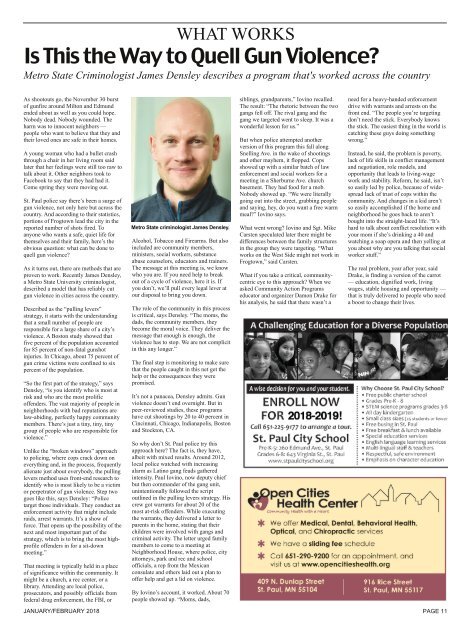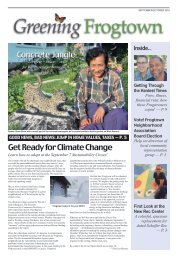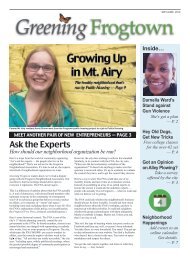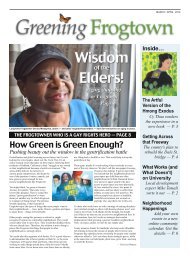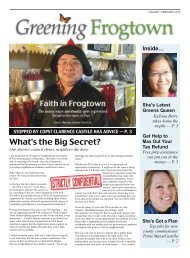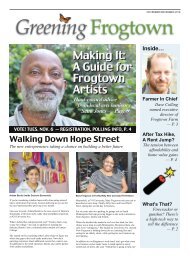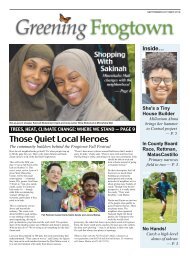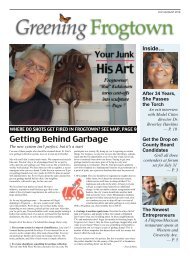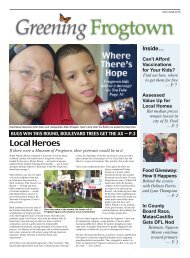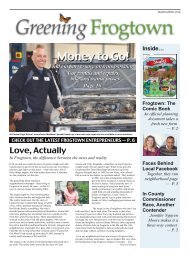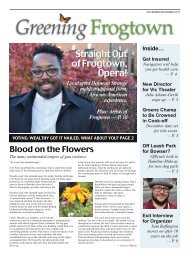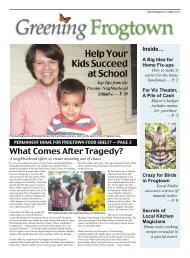GreeningFrogtownJanFeb18FINAL
Create successful ePaper yourself
Turn your PDF publications into a flip-book with our unique Google optimized e-Paper software.
WHAT WORKS<br />
Is This the Way to Quell Gun Violence?<br />
Metro State Criminologist James Densley describes a program that's worked across the country<br />
As shootouts go, the November 30 burst<br />
of gunfire around Milton and Edmund<br />
ended about as well as you could hope.<br />
Nobody dead. Nobody wounded. The<br />
harm was to innocent neighbors —<br />
people who want to believe that they and<br />
their loved ones are safe in their homes.<br />
A young woman who had a bullet crash<br />
through a chair in her living room said<br />
later that her feelings were still too raw to<br />
talk about it. Other neighbors took to<br />
Facebook to say that they had had it.<br />
Come spring they were moving out.<br />
St. Paul police say there’s been a surge of<br />
gun violence, not only here but across the<br />
country. And according to their statistics,<br />
portions of Frogtown lead the city in the<br />
reported number of shots fired. To<br />
anyone who wants a safe, quiet life for<br />
themselves and their family, here’s the<br />
obvious question: what can be done to<br />
quell gun violence?<br />
As it turns out, there are methods that are<br />
proven to work. Recently James Densley,<br />
a Metro State University criminologist,<br />
described a model that has reliably cut<br />
gun violence in cities across the country.<br />
Described as the “pulling levers”<br />
strategy, it starts with the understanding<br />
that a small number of people are<br />
responsible for a large share of a city’s<br />
violence. A Boston study showed that<br />
five percent of the population accounted<br />
for 85 percent of non-fatal gunshot<br />
injuries. In Chicago, about 75 percent of<br />
gun crime victims were confined to six<br />
percent of the population.<br />
“So the first part of the strategy,” says<br />
Densley, “is you identify who is most at<br />
risk and who are the most prolific<br />
offenders. The vast majority of people in<br />
neighborhoods with bad reputations are<br />
law-abiding, perfectly happy community<br />
members. There’s just a tiny, tiny, tiny<br />
group of people who are responsible for<br />
violence.”<br />
Unlike the “broken windows” approach<br />
to policing, where cops crack down on<br />
everything and, in the process, frequently<br />
alienate just about everybody, the pulling<br />
levers method uses front-end research to<br />
identify who is most likely to be a victim<br />
or perpetrator of gun violence. Step two<br />
goes like this, says Densley: “Police<br />
target those individuals. They conduct an<br />
enforcement activity that might include<br />
raids, arrest warrants. It’s a show of<br />
force. That opens up the possibility of the<br />
next and most important part of the<br />
strategy, which is to bring the most highprofile<br />
offenders in for a sit-down<br />
meeting.”<br />
That meeting is typically held in a place<br />
of significance within the community. It<br />
might be a church, a rec center, or a<br />
library. Attending are local police,<br />
prosecutors, and possibly officials from<br />
federal drug enforcement, the FBI, or<br />
Metro State criminologist James Densley.<br />
Alcohol, Tobacco and Firearms. But also<br />
included are community members,<br />
ministers, social workers, substance<br />
abuse counselors, educators and trainers.<br />
The message at this meeting is, we know<br />
who you are. If you need help to break<br />
out of a cycle of violence, here it is. If<br />
you don’t, we’ll pull every legal lever at<br />
our disposal to bring you down.<br />
The role of the community in this process<br />
is critical, says Densley. “The moms, the<br />
dads, the community members, they<br />
become the moral voice. They deliver the<br />
message that enough is enough, the<br />
violence has to stop. We are not complicit<br />
in this any longer.”<br />
The final step is monitoring to make sure<br />
that the people caught in this net get the<br />
help or the consequences they were<br />
promised.<br />
It’s not a panacea, Densley admits. Gun<br />
violence doesn’t end overnight. But in<br />
peer-reviewed studies, these programs<br />
have cut shootings by 20 to 40 percent in<br />
Cincinnati, Chicago, Indianapolis, Boston<br />
and Stockton, CA.<br />
So why don’t St. Paul police try this<br />
approach here? The fact is, they have,<br />
albeit with mixed results. Around 201 2,<br />
local police watched with increasing<br />
alarm as Latino gang feuds gathered<br />
intensity. Paul Iovino, now deputy chief<br />
but then commander of the gang unit,<br />
unintentionally followed the script<br />
outlined in the pulling levers strategy. His<br />
crew got warrants for about 20 of the<br />
most at-risk offenders. While executing<br />
the warrants, they delivered a letter to<br />
parents in the home, stating that their<br />
children were involved with gangs and<br />
criminal activity. The letter urged family<br />
members to come to a meeting at<br />
Neighborhood House, where police, city<br />
attorneys, park and rec and school<br />
officials, a rep from the Mexican<br />
consulate and others laid out a plan to<br />
offer help and get a lid on violence.<br />
By Iovino’s account, it worked. About 70<br />
people showed up. “Moms, dads,<br />
siblings, grandparents,” Iovino recalled.<br />
The result: “The rhetoric between the two<br />
gangs fell off. The rival gang and the<br />
gang we targeted went to sleep. It was a<br />
wonderful lesson for us.”<br />
But when police attempted another<br />
version of this program this fall along<br />
Snelling Ave. in the wake of shootings<br />
and other mayhem, it flopped. Cops<br />
showed up with a similar batch of law<br />
enforcement and social workers for a<br />
meeting in a Sherburne Ave. church<br />
basement. They had food for a mob.<br />
Nobody showed up. “We were literally<br />
going out into the street, grabbing people<br />
and saying, hey, do you want a free warm<br />
meal?” Iovino says.<br />
What went wrong? Iovino and Sgt. Mike<br />
Carsten speculated later there might be<br />
differences between the family structures<br />
in the group they were targeting. “What<br />
works on the West Side might not work in<br />
Frogtown,” said Carsten.<br />
What if you take a critical, communitycentric<br />
eye to this approach? When we<br />
asked Community Action Programs<br />
educator and organizer Damon Drake for<br />
his analysis, he said that there wasn’t a<br />
need for a heavy-handed enforcement<br />
drive with warrants and arrests on the<br />
front end. “The people you’re targeting<br />
don’t need the stick. Everybody knows<br />
the stick. The easiest thing in the world is<br />
catching these guys doing something<br />
wrong.”<br />
Instead, he said, the problem is poverty,<br />
lack of life skills in conflict management<br />
and negotiation, role models, and<br />
opportunity that leads to living-wage<br />
work and stability. Reform, he said, isn’t<br />
so easily led by police, because of widespread<br />
lack of trust of cops within the<br />
community. And changes in a kid aren’t<br />
so easily accomplished if the home and<br />
neighborhood he goes back to aren’t<br />
bought into the straight-laced life. “It’s<br />
hard to talk about conflict resolution with<br />
your mom if she’s drinking a 40 and<br />
watching a soap opera and then yelling at<br />
you about why are you talking that social<br />
worker stuff.”<br />
The real problem, year after year, said<br />
Drake, is finding a version of the carrot<br />
— education, dignified work, living<br />
wages, stable housing and opportunity —<br />
that is truly delivered to people who need<br />
a boost to change their lives.<br />
JANUARY/FEBRUARY 2018<br />
PAGE 11


